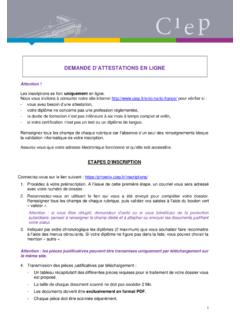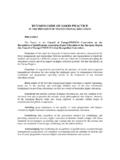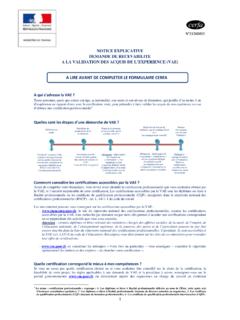Transcription of Sanitizing and Disinfecting: Is There a Difference?
1 Sanitizing and disinfecting : Is There a Difference? The terms Sanitizing and disinfecting are often used interchangeably which can cause confusion when implementing hygi-enic practices in conjunction with the use of the Environment Rating Scales (ERS). Confusion can lead to cleaning practices that are not effective, resulting in the spread of germs in group care situations. According to the 2011 Caring for Our Children (CFOC) 3rd edition standards There is a difference between the purposes for Sanitizing and disinfecting surfaces: Sanitizing : Reducing germs on inanimate surfaces to levels considered safe by public health codes or regu-lations. disinfecting : Destroying or inactivating most germs on any inanimate surface. In consideration of this new guidance the ERS authors have adjusted the expectations for cleaning practices to incorporate best practices based upon current research.
2 Details on these updates can be found in the ERS Notes for Clarification docu-ments located on the authors website: ERS Institute. Additional information is also located in the PA Position Statement documents for each scale, located at the PA Keys website. What Can be used for Sanitizing and disinfecting ? 1. EPA Registered Commer-cial Products that include directions for Sanitizing and/or disinfecting . 2. Bleach/Water Solutions Bleach/Water Solution for Sanitizing and disinfecting As per Caring for Our Children, the appropriate proportions and contact times for a bleach and water solutions includes: Sanitizing : Ratio: 1 tablespoon of bleach to 1 gallon of cool water. Contact Time: Let stand for 2 minutes, then wipe or air dry. disinfecting : Ratio: 1/4 (minimum) to 3/4 (maximum) cup of bleach to 1 gallon of cool water or 1 table-spoon (minimum) to 3 table-spoons (maximum) of bleach to 1 quart of water.
3 Contact Time: Let stand for 2 minutes, then wipe or air dry. So the old mixing ratio for bleach/water Sanitizing solution is now the ratio for disinfecting ? Why? Re-search has shown that the ratio which used to be ex-pected for use when Sanitizing actually destroys germs to the level of disinfecting , and a more dilute solution can be used effectively for Sanitizing purposes. Why shouldn t the ratio for disinfecting be used for all surfaces? Children are often in out of home child care settings for long portions of their days. Group care settings are ideal places for children to come in contact with germs brought into the settings by those around them, and therefore we must work to reduce the spread of germs appropriately to safeguard their health.
4 This means cleaning surfaces and toys a lot! Additionally, it means that children are exposed to the products we use simply by being in the same environment. Best practice then suggests that we support limiting that exposure, by using only what we need to get the job done. When should you Sanitize and When should you Disinfect? As per Caring for Our Children: Sanitizing : Appropriate for food contact surface Sanitizing (dishes, utensils, cutting boards, high chair trays, tables), toys that children may place in their mouths, and pacifiers. disinfecting : Appropriate for use on non-porous surfaces such as diaper change tables, counter tops, door and cabinet handles, toilets, and sinks used for toileting routines includ-ing facets, knobs and basins.
5 Special Note: Always clean visible debris from the surface prior to Sanitizing or dis-infecting. If using an EPA registered product a potable rinse with water after Sanitizing may be re-quired and all manufacturers directions for both processes must be followed. Pennsylvania Early Learning Keys to Quality 2012



